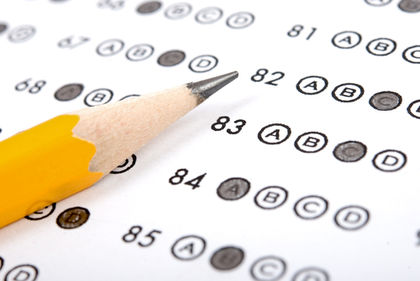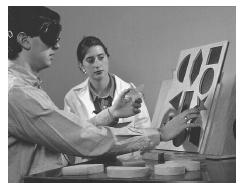Stanford-Binet Intelligence Scale

Definition
The Stanford-Binet Intelligence Scale: Fourth Edition (SB: FE) is a standardized test that measures intelligence and cognitive abilities in children and adults, from age two through mature adulthood.
Purpose
The Stanford-Binet Intelligence Scale was originally developed to help place children in appropriate educational settings. It can help determine the level of intellectual and cognitive functioning in preschoolers, children, adolescents and adults, and assist in the diagnosis of a learning disability, developmental delay, mental retardation , or giftedness. It is used to provide educational planning and placement, neuropsychological assessment, and research. The Stanford-Binet Intelligence Scale is generally administered in a school or clinical setting.
Precautions
The Stanford-Binet Intelligence Scale is considered to be one of the best and most widely used intelligence tests available. It is especially useful in providing intellectual assessment in young children, adolescents, and young adults. The test has been criticized for not being comparable for all age ranges. This is because different age ranges are administered different subtests. Additionally, for very young preschoolers, it is not uncommon to receive a score of zero due to test difficulty or the child's unwillingness to cooperate. Consequently, it is difficult to discriminate abilities in this age group among the lower scorers.
Administration and interpretation of results of the Stanford-Binet Intelligence Scale requires a competent examiner who is trained in psychology and individual intellectual assessment, preferably a psychologist .
Description
The Stanford-Binet Intelligence Scale has a rich history. It is a descendant of the Binet-Simon scale which was developed in 1905 and became the first intelligence test. The Stanford-Binet Intelligence Scale was developed in 1916 and was revised in 1937, 1960, and 1986. The present edition was published in 1986. The Stanford Binet Intelligence Scale is currently being revised and the Fifth Edition is expected to be available in the spring of 2003.
Administration of the Stanford-Binet Intelligence Scale typically takes between 45 to 90 minutes, but can take as long as two hours, 30 minutes. The older the child and the more subtests administered, the longer the test generally takes to complete. The Stanford-Binet Intelligence Scale is comprised of four cognitive area scores which together determine the composite score and factor scores. These area scores include: Verbal Reasoning, Abstract/Visual Reasoning, Quantitative Reasoning, and Short-Term Memory. The composite

The test consists of 15 subtests, which are grouped into the four area scores. Not all subtests are administered to each age group; but six subtests are administered to all age levels. These subtests are: Vocabulary, Comprehension, Pattern Analysis, Quantitative, Bead Memory, and Memory for Sentences. The number of tests administered and general test difficulty is adjusted based on the test taker's age and performance on the sub-test that measures word knowledge. The subtest measuring word knowledge is given to all test takers and is the first subtest administered.
The following is a review of the specific cognitive abilities that the four area scores measure. The Verbal Reasoning area score measures verbal knowledge and understanding obtained from the school and home learning environment and reflects the ability to apply verbal skills to new situations. Examples of subtests comprising this factor measure skills which include: word knowledge, social judgment and awareness, ability to isolate the inappropriate feature in visual material and social intelligence, and the ability to differentiate essential from non-essential detail.
The Abstract/Visual Reasoning area score examines the ability to interpret and perform mathematic operations, the ability to visualize patterns, visual/motor skills, and problem-solving skills through the use of reasoning. An example of a subtest which determines the Abstract/Visual Reasoning score is a timed test that involves tasks such as completing a basic puzzle and replicating black and white cube designs.
The Quantitative Reasoning area score measures: numerical reasoning, concentration, and knowledge and application of numerical concepts. The Quantitative Reasoning area is combined with the Abstract/Visual Reasoning area score to create an Abstract/Visual Reasoning Factor Score.
The Short-Term Memory score measures concentration skills, short-term memory, and sequencing skills. Subtests comprising this area score measure visual short-term memory and auditory short term memory involving both sentences and number sequences. In one subtest that measures visual short-term memory, the participant is presented with pictures of a bead design, and asked to replicate it from memory.
Results
The Stanford-Binet Intelligence Scale is a standardized test, which means that a large sample of children and adults were administered the exam as a means of developing test norms. The population in the sample was representative of the population of the United States based on age, gender, race or ethnic group, geographic region, community size, parental education, educational placement (normal versus special classes), etc. From this sample, norms were established. Norms are the performance of a comparison group of subjects—that nature of the group should be specified, and this usually constitutes a normal group so that the performance of the tested individual can be compared to this group and thus evaluated.
The numbers of correct responses on the given subtests are converted to a SAS score or Standard Age Score which is based on the chronological age of the test subject. This score is similar to an I.Q. score. Based on these norms, the Area Scores and Test Composite on the Stanford-Binet Intelligence Scale each have a mean or average score of 100 and a standard deviation of 16. For this test, as with most measures of intelligence, a score of 100 is in the normal or average range. The standard deviation indicates how above or below the norm a child's score is. For example, a score of 84 is one standard deviation below the norm score of 100. Based on the number of correct responses on a given subtest, an age-equivalent is available to help interpret the person's level of functioning.
Test scores provide an estimate of the level at which a child is functioning based on a combination of many different subtests or measures of skills. A trained psychologist is needed to evaluate and interpret the results, determine strengths and weaknesses, and make overall recommendations based on the findings and observed behavioral observations.
Resources
BOOKS
Sattler, Jerome. Assessment of Children. 3rd Edition. San Diego, CA, Jerome Sattler, Publisher Inc. 1992.
PERIODICALS
Caruso, J. "Reliable Component Analysis of the Stanford-Binet: Fourth Edition for 2–6-Year Olds." Psychological Assessment 13, no. 2. (2001): 827–840.
Grunau, R., M. Whitfield, and J. Petrie. "Predicting IQ of Biologically 'At Risk' Children from Age 3 to School Entry." Developmental and Behavioral Pediatrics 21, no. 6 (2000): 401–407.
ORGANIZATIONS
The American Psychological Association. 750 First St., NE, Washington, DC 20002-4242. (202) 336-5500 <www.apa.org> .
The National Association of School Psychologists. 4340 East West Highway, Suite 402, Bethesda, MD 20814. (301) 657-0270. <www.nasponline.com> .
Jenifer P. Marom, Ph.D.
I have some questions regarding the accuracy of the scales scoring after the IQ were to tested on a 7 years kid. How would the psychologist be so certain that the child is ready and trying his best to answer? Will the psychologist knows if the kid is just fooling around witnout trying any effort to answer those questions for the IQ test?